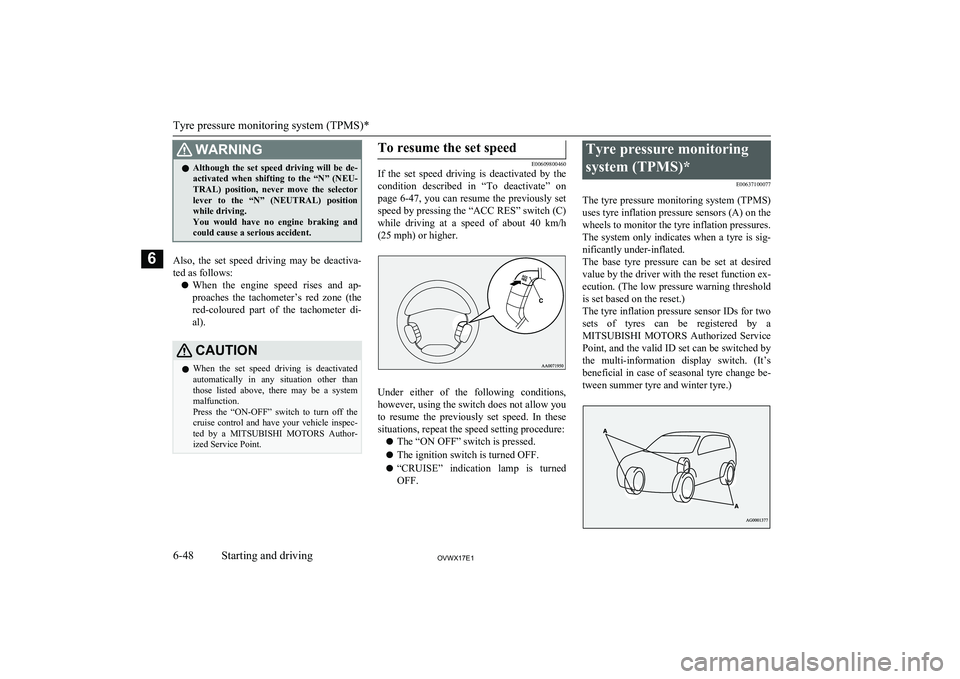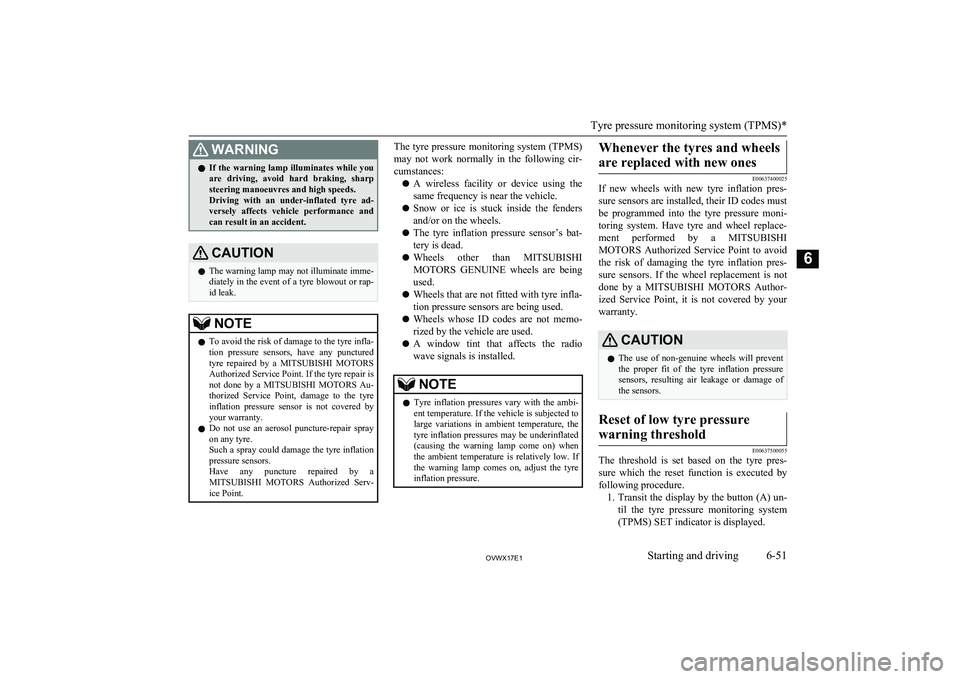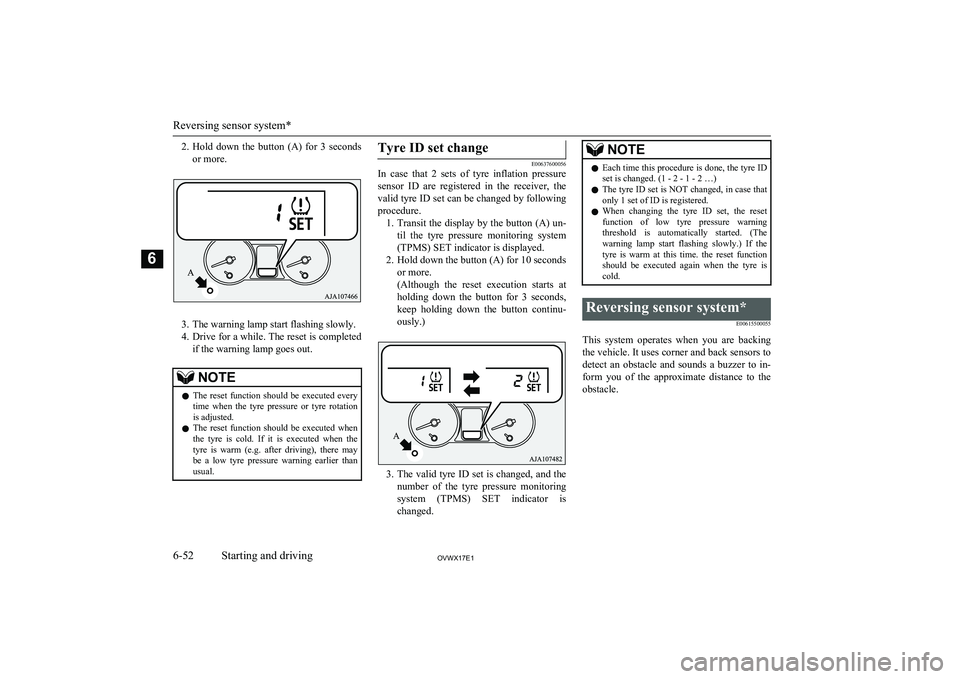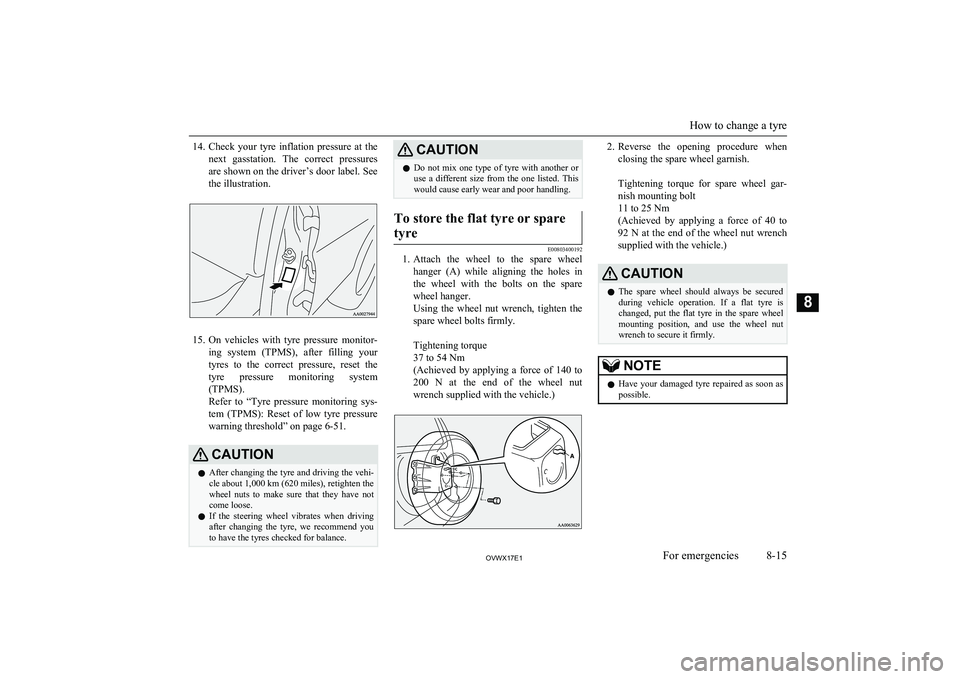TPMS reset MITSUBISHI SHOGUN 2017 Owner's Manual (in English)
[x] Cancel search | Manufacturer: MITSUBISHI, Model Year: 2017, Model line: SHOGUN, Model: MITSUBISHI SHOGUN 2017Pages: 394, PDF Size: 19 MB
Page 186 of 394

WARNINGlAlthough the set speed driving will be de-
activated when shifting to the “N” (NEU-
TRAL) position, never move the selector lever to the “N” (NEUTRAL) position
while driving.
You would have no engine braking and
could cause a serious accident.
Also, the set speed driving may be deactiva-
ted as follows:
l When the engine speed rises and ap-
proaches the tachometer’s red zone (the red-coloured part of the tachometer di-
al).
CAUTIONl When the set speed driving is deactivated
automatically in any situation other thanthose listed above, there may be a system
malfunction.
Press the “ON-OFF” switch to turn off the cruise control and have your vehicle inspec- ted by a MITSUBISHI MOTORS Author-
ized Service Point.To resume the set speed
E00609800460
If the set speed driving is deactivated by the
condition described in “To deactivate” on
page 6-47, you can resume the previously set
speed by pressing the “ACC RES” switch (C)
while driving at a speed of about 40 km/h (25 mph) or higher.
Under either of the following conditions,however, using the switch does not allow you
to resume the previously set speed. In these
situations, repeat the speed setting procedure:
l The “ON OFF” switch is pressed.
l The ignition switch is turned OFF.
l “CRUISE” indication lamp is turned
OFF.
Tyre pressure monitoring
system (TPMS)* E00637100077
The tyre pressure monitoring system (TPMS)
uses tyre inflation pressure sensors (A) on the wheels to monitor the tyre inflation pressures.
The system only indicates when a tyre is sig-
nificantly under-inflated.
The base tyre pressure can be set at desired value by the driver with the reset function ex-
ecution. (The low pressure warning threshold is set based on the reset.)
The tyre inflation pressure sensor IDs for two sets of tyres can be registered by aMITSUBISHI MOTORS Authorized Service
Point, and the valid ID set can be switched by the multi-information display switch. (It’s
beneficial in case of seasonal tyre change be-
tween summer tyre and winter tyre.)
Tyre pressure monitoring system (TPMS)*
6-48OVWX17E1Starting and driving6
Page 189 of 394

WARNINGlIf the warning lamp illuminates while you
are driving, avoid hard braking, sharp steering manoeuvres and high speeds.
Driving with an under-inflated tyre ad-
versely affects vehicle performance and
can result in an accident.CAUTIONl The warning lamp may not illuminate imme-
diately in the event of a tyre blowout or rap-
id leak.NOTEl To avoid the risk of damage to the tyre infla-
tion pressure sensors, have any punctured
tyre repaired by a MITSUBISHI MOTORS
Authorized Service Point. If the tyre repair is
not done by a MITSUBISHI MOTORS Au-
thorized Service Point, damage to the tyre
inflation pressure sensor is not covered by your warranty.
l Do not use an aerosol puncture-repair spray
on any tyre.
Such a spray could damage the tyre inflation
pressure sensors.
Have any puncture repaired by a MITSUBISHI MOTORS Authorized Serv-
ice Point.The tyre pressure monitoring system (TPMS)
may not work normally in the following cir-
cumstances:
l A wireless facility or device using the
same frequency is near the vehicle.
l Snow or ice is stuck inside the fenders
and/or on the wheels.
l The tyre inflation pressure sensor’s bat-
tery is dead.
l Wheels other than
MITSUBISHI
MOTORS GENUINE wheels are being
used.
l Wheels that are not fitted with tyre infla-
tion pressure sensors are being used.
l Wheels whose ID codes are not memo-
rized by the vehicle are used.
l A window tint that affects the radio
wave signals is installed.NOTEl Tyre inflation pressures vary with the ambi-
ent temperature. If the vehicle is subjected to large variations in ambient temperature, the tyre inflation pressures may be underinflated
(causing the warning lamp come on) when the ambient temperature is relatively low. If
the warning lamp comes on, adjust the tyre inflation pressure.Whenever the tyres and wheels
are replaced with new ones
E00637400025
If new wheels with new tyre inflation pres-
sure sensors are installed, their ID codes must be programmed into the tyre pressure moni- toring system. Have tyre and wheel replace-
ment performed by a MITSUBISHI
MOTORS Authorized Service Point to avoid
the risk of damaging the tyre inflation pres- sure sensors. If the wheel replacement is not
done by a MITSUBISHI MOTORS Author-
ized Service Point, it is not covered by your warranty.
CAUTIONl The use of non-genuine wheels will prevent
the proper fit of the tyre inflation pressure sensors, resulting air leakage or damage of
the sensors.Reset of low tyre pressure
warning threshold
E00637500055
The threshold is set based on the tyre pres- sure which the reset function is executed by
following procedure. 1. Transit the display by the button (A) un-
til the tyre pressure monitoring system
(TPMS) SET indicator is displayed.
Tyre pressure monitoring system (TPMS)*
6-51OVWX17E1Starting and driving6
Page 190 of 394

2.Hold down the button (A) for 3 seconds
or more.
3. The warning lamp start flashing slowly.
4. Drive for a while. The reset is completed
if the warning lamp goes out.
NOTEl The reset function should be executed every
time when the tyre pressure or tyre rotationis adjusted.
l The reset function should be executed when
the tyre is cold. If it is executed when the
tyre is warm (e.g. after driving), there may be a low tyre pressure warning earlier than
usual.Tyre ID set change
E00637600056
In case that 2 sets of tyre inflation pressure
sensor ID are registered in the receiver, the
valid tyre ID set can be changed by following
procedure. 1. Transit the display by the button (A) un-
til the tyre pressure monitoring system
(TPMS) SET indicator is displayed.
2. Hold down the button (A) for 10 seconds or more.
(Although the reset execution starts at
holding down the button for 3 seconds, keep holding down the button continu-
ously.)
3. The valid tyre ID set is changed, and the
number of the tyre pressure monitoring
system (TPMS) SET indicator is changed.
NOTEl Each time this procedure is done, the tyre ID
set is changed. (1 - 2 - 1 - 2 …)
l The tyre ID set is NOT changed, in case that
only 1 set of ID is registered.
l When changing the tyre ID set, the reset
function of low tyre pressure warning
threshold is automatically started. (The warning lamp start flashing slowly.) If the
tyre is warm at this time. the reset function
should be executed again when the tyre is cold.Reversing sensor system*
E00615500055
This system operates when you are backingthe vehicle. It uses corner and back sensors to detect an obstacle and sounds a buzzer to in-form you of the approximate distance to the
obstacle.
Reversing sensor system*
6-52OVWX17E1Starting and driving6
Page 307 of 394

14.Check your tyre inflation pressure at the
next gasstation. The correct pressures
are shown on the driver’s door label. See the illustration.
15. On vehicles with tyre pressure monitor-
ing system (TPMS), after filling your tyres to the correct pressure, reset the tyre pressure monitoring system(TPMS).
Refer to “Tyre pressure monitoring sys-
tem (TPMS): Reset of low tyre pressure
warning threshold” on page 6-51.
CAUTIONl After changing the tyre and driving the vehi-
cle about 1,000 km (620 miles), retighten the
wheel nuts to make sure that they have not come loose.
l If the steering wheel vibrates when driving
after changing the tyre, we recommend you to have the tyres checked for balance.CAUTIONl Do not mix one type of tyre with another or
use a different size from the one listed. This
would cause early wear and poor handling.To store the flat tyre or spare
tyre
E00803400192
1. Attach the wheel to the spare wheel
hanger (A) while aligning the holes in
the wheel with the bolts on the spare
wheel hanger.
Using the wheel nut wrench, tighten the spare wheel bolts firmly.
Tightening torque
37 to 54 Nm
(Achieved by applying a force of 140 to
200 N at the end of the wheel nut wrench supplied with the vehicle.)
2. Reverse the opening procedure when
closing the spare wheel garnish.
Tightening torque for spare wheel gar- nish mounting bolt
11 to 25 Nm
(Achieved by applying a force of 40 to
92 N at the end of the wheel nut wrench supplied with the vehicle.)CAUTIONl The spare wheel should always be secured
during vehicle operation. If a flat tyre is changed, put the flat tyre in the spare wheel
mounting position, and use the wheel nut
wrench to secure it firmly.NOTEl Have your damaged tyre repaired as soon as
possible.
How to change a tyre
8-15OVWX17E1For emergencies8